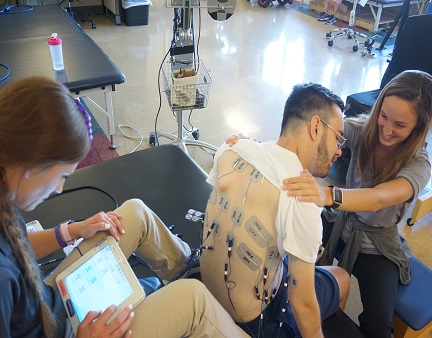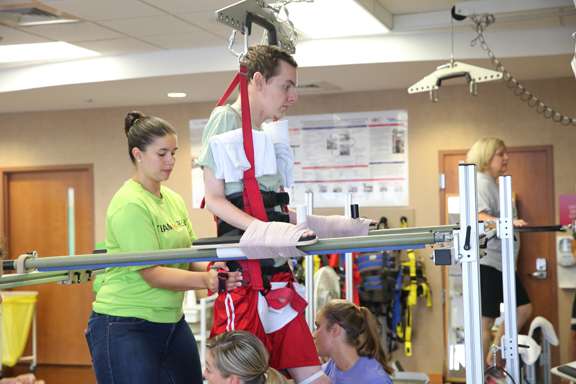C.O.R.E.
Comprehensive
The Movement Performance and Locomotor Recovery Core develops a comprehensive analysis of functional movements involving the lower limbs, trunk and upper limbs in individuals with spinal cord injuries. We use this approach to understand the way you move and optimize the design of your individualized training interventions that will help you to improve your ability to perform functional movements important for your quality of life. Our team is composed of researchers, research technicians, physical therapists, occupational therapists and activity-based technicians who work together to provide excellent clinical care and scientific expertise in an environment that supports individuals with spinal cord injuries.
Objective
We use state-of-the-art medical and research equipment to obtain objective assessments of locomotor and upper extremity functions and use those assessments to design training interventions. Our assessments allow us to better understand how your injury affect the way you move, and design rehabilitation programs that are suited to you to help improve your ability to perform functional tasks of daily life.
Assessments:
- The International Standards for Neurological Classification of Spinal Cord Injury (ISNCSCI): We use this examination to score your level of motor and sensory impairment and the severity of your spinal cord injury.
- Modified Ashworth Scale: We evaluate the resistance of your muscle when a clinician moves your joint through a range of motion.
- Neuromuscular Recovery Scale: We evaluate your ability to perform 11 different functional tasks in sitting and/or standing position. You will be provided with manual assistance while you perform these tasks to ensure your safety.
- 10 meter walk test: This assessment allows us to evaluate your level of mobility. We determine how fast you can safely walk on a straight line over a 10m distance.
- 6min walk test: This assessment allows us to evaluate your level of endurance. We determine the maximal distance you can walk over a 6 minutes period around a short track.
- BERG Balance Scale: We use this assessment to assess your static and dynamic balance and falls risk. It includes 14 functional tasks to be performed in in sitting and standing positions. We score your performance to each task based on how long and how much assistance you need.
- Timed Up and Go Test: We use this test to assess your mobility, balance, walking ability and fall risk. Starting seated in an armchair (17-18.5 inches height) with your back against the chair, you are instructed to stand, walk 3 meters at safe, comfortable pace, turn around, walk back to the chair, and have a seat.
- Manual Muscle Test: We use this test to evaluate the strength of your muscles across your entire body (upper limbs, trunk, lower limbs).
- The Activity-based Balance Level Evaluation (ABLE Scale): Using a series of tasks, we evaluate your balance while you are sitting, standing, and walking.
- Standing: We test how long you can stand using your current assistive device.
- Walking: We assess your ability to walk both over ground and on a treadmill that has been fitted with a harness specifically designed for individuals with spinal cord injury. We measure the basic spatio-temporal parameters (step length, step frequency, stance duration, swing duration, double-support duration) of your gait while you are walking. We study the movement of your body segments (trunk, pelvis, thighs, lower legs, feet) and joints (hip, knee, ankle). We analyze the forces you apply to the ground while you are walking. We also study how your nervous system activates the muscles that generate the walking movement.
- Cycling: We assess your ability to pedal on a cycle ergometer specifically designed for individuals with spinal cord injury. We study the movement of your body segments (pelvis, thighs, lower legs, feet) and joints (hip, knee, ankle). We analyze the forces you apply to the pedals when you are pedaling. We also study how your nervous system activate the muscles that generate the pedaling movement.
- Reaching: We assess your ability to move your hands towards a series of target positions. We study how fast and how precisely you can reach targets that are located in different positions. We study the movement of your body segments (pelvis, trunk, upper arms, lower arms, hands) and joints (shoulder, elbow, wrist). We also study how your nervous system activates the muscles that generate the reaching movement.
- Grasping: We assess your ability to pick up an object with your hands. We study how much force you can produce with your hand and finger muscles and how precisely you can adjust this force. We analyze the forces you produce alongside how your nervous system activates the muscles.
Interventions:
- Exercises to improve locomotor function: We design training individualized interventions consisting of gait-specific exercises (walking over ground and on a treadmill) and non-gait specific exercises (bipedal and quadrupedal cycling, elliptical exercises) selected from your locomotor function assessment.
- Exercises to improve upper extremity function: We design individualized training interventions consisting of reaching, grasping, arm swing and daily tasks selected from your upper extremity function assessment.
- Stimulation techniques: Alongside the exercises presented above, we use various stimulation techniques such as neuromuscular electrical stimulation and spinal cord transcutaneous stimulation to further improve the ability of your nervous system to control the movements while increasing the ability of your muscles to produce force.
What to Expect During Testing
- Our experienced scientists, research technicians, physical and occupational therapists and activity-based technicians perform assessments in dedicated laboratory spaces and evaluation rooms
- Any special preparations or requirements, such as stopping certain medication, is communicated prior to testing
- A medical history interview and physical exam are performed prior to any testing
- Blood pressure and heart rate are monitored throughout any testing
Research-driven
We employ a “Discovery-to-Recovery” approach and work closely across disciplines to expand knowledge and bring innovative treatments to practice so that individuals with spinal cord injuries can experience their own personal Victory Over Paralysis. Our work is published in leading scientific journals.
Evidence-based
The majority of individuals with SCI experience neurogenic dysfunction that affects their ability to perform functional tasks. The assessments we perform are leading to greater understanding of how we can optimize the design of Activity-Based Interventions and the use of stimulation techniques such as Neuromuscular Electrical Stimulation, spinal cord Epidural Stimulation or spinal cord Transcutaneous Stimulation to regain locomotor and upper extremity function and improve quality-of-life for individuals with spinal cord injuries. |
Adult NeuroRecovery
Translational Cores
Metabolic, Neuromuscular, and Skeletal
Cardiovascular and Pulmonary
Movement Performance and Locomotor Recovery
Urogenital and Bowel
Neurophysiology
Engineering
Research Medical
Biostatistics, Outcomes, Database, and Communications
Finance and Administrative
Movement Performance and Locomotor Recovery Clinic
Investigators
|
















